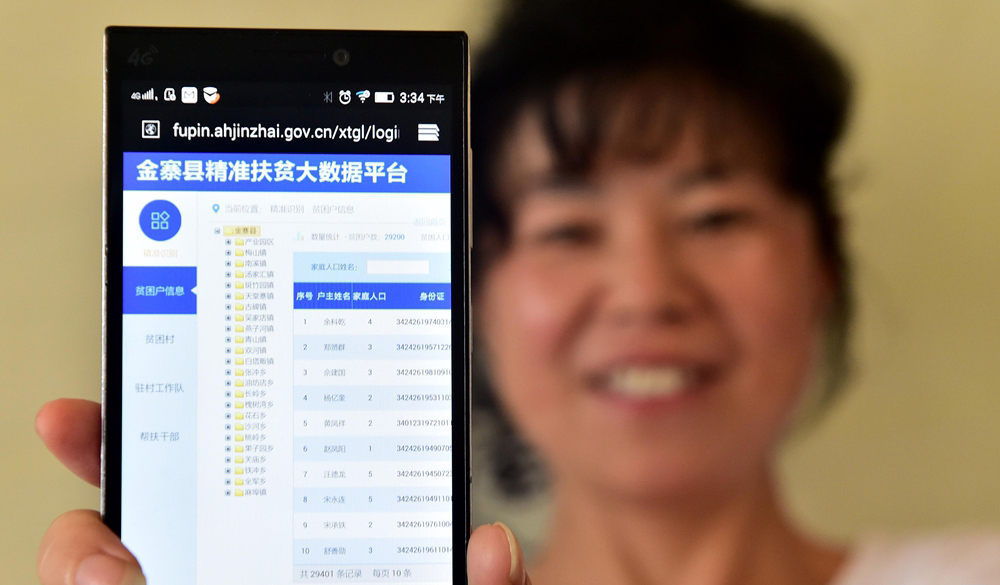Big data helps to innovate targeted poverty alleviation

A staff member of local department in Jinzhai County, Anhui Province is showing a mobile platform that collects big data of poverty alleviation.
Targeted poverty alleviation is a strategy by which China aims to achieve a moderately prosperous society. At present, the work has entered a crucial stage, yet a number of problems remain in terms of implementation.
Lack of foresight
The circumstances of impoverished people vary due to a variety of reasons. Related departments have not constructed an integrated database of low-income village households, basic living allowance and student subsidies, so staff are not able to verify the collected data. As a result, the targets of poverty alleviation may have been neglected or mismatched.
Some supporting policies and measures fail to meet local demands, but the lack of policies is not the only obstacle in the path of poverty alleviation. Policymakers do not have the multi-source data to thoroughly investigate poverty and its causes when designing and implementing policies, which has led to a number of problems, such as inefficient use of resources and ineffective support work.
In terms of management, a dynamic early-warning mechanism should be optimized, the core task of which is to include or exclude targets and follow-up policies in a timely fashion. However, the management departments in a number of regions have not conducted early-warning management of data concerning poverty reduction. This allows some people or regions to continue to benefit from supporting policies even after overcoming poverty.
Suitable measures
Big data technology has the potential to innovate management decisions through swift collection, analysis, modeling and processing of massive amounts of data. Targeted poverty reduction can make practical use of big data to deal with problems.
Big data can accurately identify the needs of people or regions in a timely fashion, which is a requirement of targeted poverty alleviation. It enables an information system based on which data from various departments can be analyzed, compared and modeled with external multi-source data to precisely identify people or regions with the greatest need.
Big data can help to handle the relationship between demand and supply and carry out proper measures based on such factors as population, regional characteristics as well as causes and types of poverty.
Targeted management is a model that ensures the implementation of policies and effective use of funds by tracking dynamic data about the execution of policies and projects.
Integration and analysis of multi-source big data can facilitate targeted evaluation of poverty alleviation and the quantitative assessment of the whole process. An index system and a digitized evaluation system can be embedded into the management database of poverty-reduction information while big data technology can be adopted to collect, analyze and model relevant statistics, thus guaranteeing policy execution and clarifying management responsibilities.
Mobile platform
A management system of poverty-alleviation information can collect, integrate, store and search data as well as analyze and compare it, but it is still in the initial stage. To maximize the advantage of big data, related pattern for poverty alleviation should be optimized, so that identification, support, management and evaluation can all be targeted.
Efforts should be made to establish a big data platform that can be applied to mobile terminals. The platform can process multi-source data in different ways to identify the people and regions that are in most dire need and choose appropriate approaches to help them. Digitized evaluation and dynamic early warning are available during the whole process. Management staff should track the data of the populations and regions with the greatest need, and anticipate their requirements in the near future, the potential for them to escape poverty and the possibility of relapse. Thus, all people and regions can be involved in the construction of a moderately prosperous society.
In addition, big data and poverty-reduction mechanisms should be the focus of innovation. The collaborative innovation of technology and mechanism lays the foundation for a policy dividend and a technology dividend, and the targets of poverty alleviation can benefit from it. Management departments are responsible for this work to combine the strength of off-line practices and online platforms so that big data can effectively innovate targeted poverty alleviation.

 PRINT
PRINT CLOSE
CLOSE